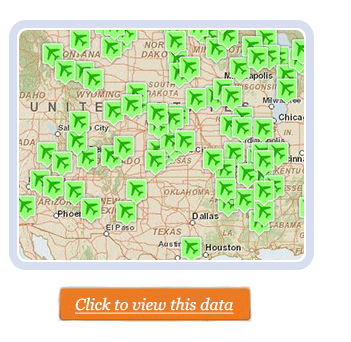Essential Air Service Dataset
The Essential Air Service (EAS) is a federal subsidy program created in the 1970s as part of airline deregulation. Though the program was intended to be temporary, taxpayers across the nation now spend more than $200 million each year so that a privileged few in just 117 communities can be guaranteed convenient air service. 
Taxpayers for Common Sense (TCS) has done a comprehensive review of all current EAS agreements, which are based on proposals made by individual airlines to the Department of Transportation. The airlines lay out the terms they would require to provide service to what would be an otherwise unprofitable market. To put it another way, the airlines tell the government how much they will need to operate a route they would otherwise not fly.
Our review of these agreements has resulted in the most up-to-date overview of how much it costs taxpayers each year to maintain service to these rural airports, how much it costs per passenger, and how many passengers are benefitting from the subsidized service.
At present, there is nearly $218 million worth of EAS contracts on the books to service 117 communities.
In addition, here is an analysis of how this data informs what may change within the program based on last year's FAA reauthorization bill.
Some highlights from the data:
- Taxpayers spend a high of $3.9 million annually to subsidize air service from Presque Isle, Maine to Boston, Massachusetts and a low of $342,560 for passengers from Joplin, Missouri to Dallas, Texas.
- Joplin also has the lowest subsidy per passenger, at $6.26. The highest subsidy per passenger is Lewistown, Montana for service to Billings, Montana, which costs taxpayers $1,905 every time somebody flies that route. The drive from Lewistown to Billings is not much more than 2 hours long!
- In general, Michigan is the biggest winner from the EAS program (excluding Alaska). There are nine airports in Michigan that qualify for EAS funding, with an estimated cost to taxpayers of $17.6 million. Montana also has nine subsidized airports and receives nearly $12.0 million. Mississippi is second in total amount of subsidy with $12.4 million supporting four airports.
- Fifteen states receive no benefit from the EAS program.
Methodology
To compile this EAS data, TCS reviewed the most recent “rate order” issued by the U.S. Department of Transportation for each EAS airport. These rate orders contain the major of information included in the data set, including total dollar value, rate per flight, start and end dates, connecting airport, and more. These rate orders were obtained from www.regulations.gov, using the unique “docket” number assigned to each EAS airport. The 2011 enplanement data is from Federal Aviation Administration sources (http://1.usa.gov/aAVKrp). The “calculated subsidy per passenger” is calculated using total contract value and enplanements. Note that while the contract values are 2013 figures, the most recent enplanement data is from 2011. Though this will make for small variations in current per passenger subsidy rates, the differences are expected to be minor.
Terms of Use
Because all of the data we offer is public information, we ask that all users agree to these basic terms of use, that:
- information provided by TCS in whatever form is meant for research, educational, or journalistic purposes only;
- TCS Data shall not be used for commercial purposes, to solicit contributions, or sold to third-parties;
- and that appropriate credit will be given to TCS for all reports, articles, mashups, or other use of our data, including a link back to our website for all items published on the web.










